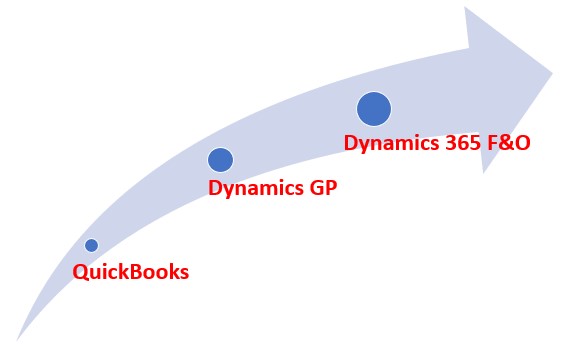As an on-premises Microsoft Dynamics GP customer, if you have concluded you need an ERP upgrade because your organization has outgrown the functional and technical capabilities of your current GP software, then your next step is critical. Critical because your new ERP platform can be either a strategic tool that fuels growth or a boat anchor that hampers progress or even sets back the business.
Most companies evolve similarly in terms of their ERP software needs. In the Microsoft world of ERP software, we have seen organizations follow the QuickBooks (QB) to Dynamics GP to Dynamics D365 Finance & Operations (D365FO) pathway on many occasions.

Today, that historical migration model has been complicated by the introduction of Dynamics 365 Business Central (BC) as a viable upgrade option for GP customers. (Note: The rest of this article will use the word “upgrade” to refer to any change to a new ERP from the current state.) The BC route seems especially viable if your only source of information is Microsoft and BC partner marketing, which distills the on-premises GP upgrade options into a straightforward choice between staying on GP or migrating to BC.
The critical question we have to answer is, “Is that really our best or only option”?
In my experience, that message has two consequences that backfire on the Microsoft ERP market. Before looking at those, let’s assume that the on-premise GP installed base is segmented into three types of companies:
- The GLAPAR – Companies that use the financial functionalities (general ledger, accounts payable, and accounts receivables) primarily. An upgrade to BC for this group would be the easiest and least expensive.
- The Workhorse – Companies that need the deeper functionality provided by GP and its army of third-party ISV solutions to create a perfect business solution. These companies are the vast majority of the GP installed base and the focus of our GP to BC podcast series (see parts 1, 2, and 3). For this class of GP company, an upgrade to BC is not a straightforward decision, as we have shown in detail.
- The Enterprise-Ready – Companies that are torturing their GP software to meet their business or technology needs. For these companies, GP cannot keep up with their growth and functional requirements.
Let’s focus on the enterprise-ready GP customer because they have the most to lose in making the wrong ERP upgrade decision.
If you have significantly outgrown your GP software, there is a good chance that you have also already outgrown the current capabilities of BC. In this case, an upgrade to BC would be, at best, a lateral move. Without some overriding reason to justify that move, a sideways upgrade is an expensive proposition at best and malpractice by your partner at worst.
If you are an enterprise-ready GP company, what are your options? In our experience, these are the typical options:
- Circumvent your GP partner and launch a software search across the ERP market.
- Work with your GP partner on a BC upgrade.
- Work with your GP partner on an upgrade to a non-Microsoft ERP solution.
- Work with a GP partner that has incorporated D365FO into their portfolio and upgrade to a real Microsoft enterprise-level ERP platform.
Let’s look at each of these options.
Many GP companies feel that they have not only outgrown their ERP software but also their GP partner. In this scenario, the partner is not involved in the search and decision-making process for a new ERP solution.
If your GP partner is working with BC exclusively as their alternative ERP solution, then the adage, “if you have a hammer, the entire world looks like a nail” applies.
Alternatively, many GP partners now represent non-Microsoft ERP software options. The reasons for this are complicated and deeply rooted in the love-hate relationship between GP partners and Microsoft.
As a partner that has successfully moved GP companies to AX and now to D365FO, we see this as a logical path that has historically been ignored by the GP partner base. The reasons for the lack of support for this option are complex and challenging to overcome. There is a solution that works in the best interest of the Microsoft ERP community and, more importantly, the GP enterprise-ready customer. Instead of focusing on marketing messaging, we propose an in-depth review of your business requirements mapped onto BC and F&O in terms of:
- Functionality
- Technology
- Cost
For a trusted evaluation, include at least two outside firms with experience in both BC and D365FO. The critical step is a side-by-side comparison of critical business functionality using your data and live software.
We see D365FO as a valid but underused path for the GP company looking to stay in the Microsoft ERP family while making the best software decision.
Upcoming podcasts in our series will delve into more details of the differences between BC and D365FO that GP users should consider when evaluating their future options.
This article was written by Peter Joeckel who is the President and Founder of TurnOnDynamics and co-authored by Karen (Floyd) Riordan, VP Sales & Marketing for Menlo Technologies, a Quisitive company.

;)


